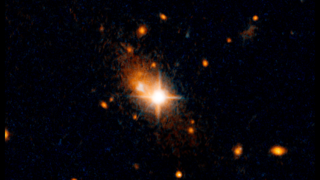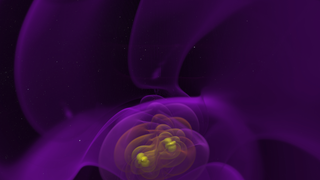Universe
ID: 12216
On Sept. 14, waves of energy traveling for more than a billion years gently rattled space-time in the vicinity of Earth. The disturbance, produced by a pair of merging black holes, was captured by the Laser Interferometer Gravitational-Wave Observatory (LIGO) facilities in Hanford, Washington, and Livingston, Louisiana. This event marked the first-ever detection of gravitational waves and opens a new scientific window on how the universe works.
Less than half a second later, the Gamma-ray Burst Monitor (GBM) on NASA's Fermi Gamma-ray Space Telescope picked up a brief, weak burst of high-energy light consistent with the same part of the sky. Analysis of this burst suggests just a 0.2-percent chance of simply being random coincidence. Gamma-rays arising from a black hole merger would be a landmark finding because black holes are expected to merge “cleanly,” without producing any sort of light.
Detecting light from a gravitational wave source will enable a much deeper understanding of the event. With its wide energy range and large field of view, the GBM is the premier instrument for detecting light from short gamma-ray bursts (GRBs), which last less than two seconds. They are widely thought to occur when orbiting compact objects, like neutron stars and black holes, spiral inward and crash together. These same systems also are suspected to be prime producers of gravitational waves.
Currently, gravitational wave observatories possess relatively blurry vision. For the September event, dubbed GW150914 after the date, LIGO scientists could only trace the source to an arc of sky spanning an area of about 600 square degrees, comparable to the angular area on Earth occupied by the United States.
Assuming the GBM burst is connected to this event, the GBM localization and Fermi's view of Earth combine to reduce the LIGO search area by about two-thirds, to 200 square degrees. With a burst better placed for the GBM’s detectors, or one bright enough to be seen by Fermi’s Large Area Telescope, even greater improvements are possible.
Black hole mergers were not expected to emit significant X-ray or gamma-ray signals because orbiting gas is needed to generate light. Theorists expected any gas around binary black holes would have been swept up long before their final plunge. For this reason, some astronomers view the GBM burst as most likely a coincidence and unrelated to GW150914. Others have developed alternative scenarios where merging black holes could create observable gamma-ray emission. It will take further detections to clarify what really happens when black holes collide.

NASA's Fermi Preps to Narrow Down Gravitational Wave Sources
Less than half a second later, the Gamma-ray Burst Monitor (GBM) on NASA's Fermi Gamma-ray Space Telescope picked up a brief, weak burst of high-energy light consistent with the same part of the sky. Analysis of this burst suggests just a 0.2-percent chance of simply being random coincidence. Gamma-rays arising from a black hole merger would be a landmark finding because black holes are expected to merge “cleanly,” without producing any sort of light.
Detecting light from a gravitational wave source will enable a much deeper understanding of the event. With its wide energy range and large field of view, the GBM is the premier instrument for detecting light from short gamma-ray bursts (GRBs), which last less than two seconds. They are widely thought to occur when orbiting compact objects, like neutron stars and black holes, spiral inward and crash together. These same systems also are suspected to be prime producers of gravitational waves.
Currently, gravitational wave observatories possess relatively blurry vision. For the September event, dubbed GW150914 after the date, LIGO scientists could only trace the source to an arc of sky spanning an area of about 600 square degrees, comparable to the angular area on Earth occupied by the United States.
Assuming the GBM burst is connected to this event, the GBM localization and Fermi's view of Earth combine to reduce the LIGO search area by about two-thirds, to 200 square degrees. With a burst better placed for the GBM’s detectors, or one bright enough to be seen by Fermi’s Large Area Telescope, even greater improvements are possible.
Black hole mergers were not expected to emit significant X-ray or gamma-ray signals because orbiting gas is needed to generate light. Theorists expected any gas around binary black holes would have been swept up long before their final plunge. For this reason, some astronomers view the GBM burst as most likely a coincidence and unrelated to GW150914. Others have developed alternative scenarios where merging black holes could create observable gamma-ray emission. It will take further detections to clarify what really happens when black holes collide.

Used Elsewhere In
Related
Credits
Francis Reddy (University of Maryland College Park): Lead Science Writer
Swarupa Nune (InuTeq): Producer
Scott Wiessinger (USRA): Producer
Francis Reddy (University of Maryland College Park): Visualizer
Walt Feimer (KBR Wyle Services, LLC): Animator
Ernie Wright (USRA): Data Visualizer
Christopher E. Henze (NASA/ARC): Scientist
John G. Baker (NASA/GSFC): Scientist
Bernard J. Kelly (UMBC): Scientist
Swarupa Nune (InuTeq): Producer
Scott Wiessinger (USRA): Producer
Francis Reddy (University of Maryland College Park): Visualizer
Walt Feimer (KBR Wyle Services, LLC): Animator
Ernie Wright (USRA): Data Visualizer
Christopher E. Henze (NASA/ARC): Scientist
John G. Baker (NASA/GSFC): Scientist
Bernard J. Kelly (UMBC): Scientist
Please give credit for this item to:
NASA's Goddard Space Flight Center. However, individual items should be credited as indicated above.
NASA's Goddard Space Flight Center. However, individual items should be credited as indicated above.
Short URL to share this page:
https://svs.gsfc.nasa.gov/12216
Mission:
Fermi Gamma-ray Space Telescope
This item is part of these series:
Astrophysics Simulations
Astrophysics Stills
Keywords:
SVS >> HDTV
SVS >> Hyperwall
SVS >> Black Hole
SVS >> Astrophysics
SVS >> Space
SVS >> Fermi
NASA Science >> Universe
https://svs.gsfc.nasa.gov/12216
Mission:
Fermi Gamma-ray Space Telescope
This item is part of these series:
Astrophysics Simulations
Astrophysics Stills
Keywords:
SVS >> HDTV
SVS >> Hyperwall
SVS >> Black Hole
SVS >> Astrophysics
SVS >> Space
SVS >> Fermi
NASA Science >> Universe













